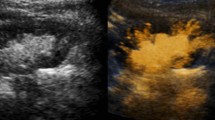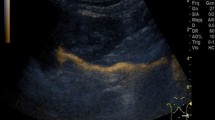Abstract
The purpose of this study was to evaluate bladder function in children with vesicoureteral reflux (VUR) by means of indirect radionuclide cystography (IRNC), and to investigate whether IRNC can identify those children with voiding dysfunction. The study enrolled 74 neurologically intact children, 14 boys and 60 girls aged 2–14 years, with VUR documented using contrast micturating cystourethrography as the initial method. In all patients, IRNC was performed using technetium-99m diethylene triamine penta-acetate (DTPA). Based on the urodynamic findings, three groups were distinguished: a group with VUR and normal urodynamic findings (n=27), a group with VUR and detrusor hyper-reflexia (n=43) and a group with VUR and detrusor-sphincter dyssynergia (n=4). A control group comprised 64 healthy children, aged 2–13 years, without any symptoms of lower urinary tract dysfunction. The dynamics of bladder emptying were studied in the posterior view after intravenous injection of 37 MBq/10 kg b.w. DTPA, with acquisition of 90 2-s frames during voiding. The parameters evaluated were: voided urine volume (VV), bladder capacity, functional bladder capacity (FBC), residual urine, voiding time, average flow rate, peak flow rate (PFR) and ejection fraction (EF). With regard to the final urodynamic diagnosis, FBC, PFR and EF were found to be significant IRNC predictor variables using the logistic regression method. If abnormality on at least two of the three significant predictor variables was taken as the criterion of voiding dysfunction, the overall sensitivity, specificity and accuracy of IRNC in the detection of voiding dysfunction were 81%, 78% and 80%, respectively. Three radionuclide voiding patterns were detected in children with VUR: (1) a normal voiding pattern characterised by normal FBC with near-normal PFR and EF values, (2) a markedly reduced FBC with significantly reduced VV, PFR and EF values (in children with bladder instability), and (3) a higher bladder volume with a near-normal value for PFR and a slightly reduced or near-normal EF (in children with detrusor-sphincter dyssynergia). This study confirmed the association between lower urinary tract dysfunction and congenital VUR. IRNC was found to be a simple, non-invasive method which allows reliable differentiation of voiding patterns in patients with VUR. IRNC can be used as a first-line method for screening in children with VUR to identify those with abnormal voiding patterns.

Similar content being viewed by others
References
Gobet R, Cisek LJ, Chang B, Barnewolt CE, Retik AB, Peters CA. Experimental fetal vesicoureteral reflux induces renal tubular and glomerular damage, and is associated with persistent bladder instability. J Urol 1999; 162:1090–1095.
Scholtmeijer RJ, Nijman RJ. Vesicoureteral reflux and videourodynamic studies: results of a prospective study after three years of follow-up. Urology 1994; 43:714–718.
Griffiths DJ, Scholtmeijer RJ. Vesicoureteral reflux and lower urinary tract dysfunction: evidence for 2 different reflux/dysfunction complexes. J Urol 1987; 137:240–244.
Chandra M, Maddix H, McVicar M. Transient urodynamic dysfunction of infancy: relationship to urinary tract infections and vesicoureteral reflux. J Urol 1996; 155:673–677.
Greenfield SP, Wan J. The relationship between dysfunctional voiding and congenital vesicoureteral reflux. Curr Opin Urol 2000; 10:607–610.
Allen TD. The non-neurogenic neurogenic bladder. J Urol 1977; 117:232–234.
Martin DC, Datta NS,Schwetz B. The occult neurological bladder. J Urol 1971; 105:733–736.
Hjälmås K. Nocturnal enuresis: basic facts and new horizons. Eur Urol 1998; 33 Suppl 3:53–57.
Wojcik LJ, Kaplan GW. The wet child. Urol Clin North Am 1998; 25:735–745.
Abrams P, Blaivas JG, Stanton SL, Anderson JT. Standardization of lower urinary tract function. Neurourol Urodynam 1988; 7:403–427.
Ewalt DH, Bauer SB. Pediatric neurourology. Urol Clin North Am 1996; 23:501–510.
Groshar D, Emboni OM, Sazbon A. Comparison of a radionuclide method and catheterization for the measurement of residual volume of urine in the bladder. Clin Nucl Med 1987; 12:363–364.
Groshar D, Embon OM, Sazbon A, Koritny ES, Frenkel A. Radionuclide assesment of bladder outlet obstruction: a noninvasive ( 1-step) method for measurement of voiding time, urinary flow rates and residual urine. J Urol 1988; 139:266–269.
Vlajković M, Bogićević M, Rajić M, Ilić S, Slavković A, Stefanović V, Artiko V. Radionuclide voiding pattern in children with unstable bladde. Nucl Med Rev 2000; 3:53–56.
Vlajković M, Ilić S, Rajić M, Bogićević M, Slavković A, Golubović E. Quantitative indirect radionuclide cystography in day- and night-wetting children. J Nucl Med 2000; 41:330P.
Lebovitz RL, Olbing H, Perkkulainen KV, Smellie JM, Tammien-Mobius TE. International reflux study in children. International system of radiographic grading of vesicoureteral reflux. Pediatr Radiol 1985; 15:105–109.
Berger RM, Maizels M, Morgan GC, Conway JJ, Firlit CF. Bladder capacity (ounces) equals age (years) plus 2 predicts normal bladder capacity and aids in diagnosis of abnormal voiding patients. J Urol 1983; 129:347–349.
Kaefer M, Zurakowski D, Bauer SB, Retik AB, Peters CA, Atala A, Treves ST. Estimating normal bladder capacity in children. J Urol 1997; 158:2261–2264.
Eller DA, Austin PF, Tanguay S, Homsy YL. Daytime functional bladder capacity as a predictor of response to desmopressin in monosymptomatic nocturnal enuresis. Eur Urol 1998: 3 Suppl 3:25–29.
Vega-P JM, Pascual LA. High-pressure bladder: an underlying factor mediating renal damage in the absence of reflux? BJU Int 2001; 87:581–584.
Willemsen J, Nijman RJM. Vesicoureteral reflux and videourodynamic studies: results of a prospective study. Urology 2000; 55: 939–943.
Taylor CM. Unstable bladder activity and the rate of resolution of vesico-ureteric reflux. Control Nephrol 1984; 39:238–246.
Scholtmeijer RY, Griffiths DJ. The role of videourodynamic studies in diagnosis and treatment of vesicoureteral reflux. J Pediatr Surg 1990; 25:669–671.
Homsy YL, Nsouli I, Hamburger B. Effects of oxybutinin on vesicoureteral reflux in children. J Urol 1985; 134:1168–1171.
Koff SA, Wagner TT, Jayanthi VR. The relationship among dysfunctional elimination syndromes, primary vesicoureteral reflux and urinary tract infections in children. J Urol 1998; 160:1019–1022.
Author information
Authors and Affiliations
Corresponding author
Rights and permissions
About this article
Cite this article
Vlajković, M., Ilić, S., Bogićević, M. et al. Radionuclide voiding patterns in children with vesicoureteral reflux. Eur J Nucl Med Mol Imaging 30, 532–537 (2003). https://doi.org/10.1007/s00259-002-1077-x
Received:
Accepted:
Published:
Issue Date:
DOI: https://doi.org/10.1007/s00259-002-1077-x




